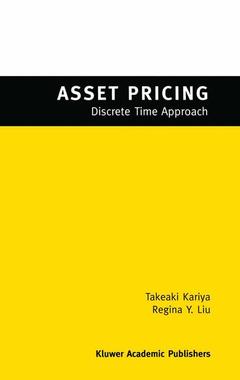Asset Pricing, 2003 -Discrete Time Approach-
Langue : Anglais
Auteurs : Kariya T., Liu Regina

1. Main Goals The theory of asset pricing has grown markedly more sophisticated in the last two decades, with the application of powerful mathematical tools such as probability theory, stochastic processes and numerical analysis. The main goal of this book is to provide a systematic exposition, with practical appli cations, of the no-arbitrage theory for asset pricing in financial engineering in the framework of a discrete time approach. The book should also serve well as a textbook on financial asset pricing. It should be accessible to a broad audi ence, in particular to practitioners in financial and related industries, as well as to students in MBA or graduate/advanced undergraduate programs in finance, financial engineering, financial econometrics, or financial information science. The no-arbitrage asset pricing theory is based on the simple and well ac cepted principle that financial asset prices are instantly adjusted at each mo ment in time in order not to allow an arbitrage opportunity. Here an arbitrage opportunity is an opportunity to have a portfolio of value aat an initial time lead to a positive terminal value with probability 1 (equivalently, at no risk), with money neither added nor subtracted from the portfolio in rebalancing dur ing the investment period. It is necessary for a portfolio of valueato include a short-sell position as well as a long-buy position of some assets.
1. Introduction.- 1 Main Goals.- 2 The Importance of The No-Arbitrage Theory.- 3 The Discrete Time Approach and Some Key Features of This Book.- 4 Comparisons with Other Textbooks.- 5 A Brief Summary of the Contents.- 2. Options, Futures and Other Derivatives.- 1 Overview.- 2 No-Arbitrage and Put-Call Parity.- 3 Exotic Options.- 4 Forward Contracts and Futures.- 3. Basic Probability Theory.- 1 Overview.- 2 Conditional Distributions and Conditional Expectations.- 3 Multivariate Normal Distribution and Normal Mixture Distribution.- 4 Nonlinear Time Series Model.- 4. Pricing Models for Financial Assets.- 1 Overview.- 2 Stochastic Processes and Brownian Motion.- 3 Martingale and Product Process.- 4 log-DD Process and Change of Probability Measures.- 5. General No-Arbitrage Asset Price Theory.- 1 Overview.- 2 Basic Framework of No-Arbitrage Price Theory.- 3 Condition for No-Arbitrage.- 4 Price Theory for Derivatives and the Black-Scholes Formula.- 5 No-Arbitrage Binomial Process and Replicability of an Option.- 6 Martingale Condition for log-DD Process.- 6. Model Specifications in Applications.- 1 Overview.- 2 Self-Consistency Tests for Models.- 3 Multi-Factor Model — Identifiability and Estimation.- 4 Model under Original Measure Q vs Risk Neutral Model under Equivalent Measure Q*.- 7. Valuation of Derivatives Via Monte Carlo Methods.- 1 Overview.- 2 Monte Carlo Method.- 3 Variance Reduction Methods.- 4 General Theory for CV Methods.- 8. Stock Option Theory and Its Applications.- 1 Overview.- 2 General Price Theory for a Stock Option.- 3 Black-Scholes (BS) Formula.- 4 BS Option Portfolios.- 5 Valuation of Exotic Options.- 6 GARCH Model and Stochastic Volatility Model.- 7 Valuation of an American Put.- 9. Currency Options.- 1 Overview.- 2 Pricing Currency Options.- 3Currency Options Containing Stocks.- 4 A Condition for No-Arbitrage.- 10. The Term Structure of Spot Rates.- 1 Overview.- 2 Spot Rate and No-Arbitrage Price of a Discount Bond.- 3 One Factor Term Structure Model for Spot Rates.- 4 Empirical Viewpoint on CIR Type Model.- 5 Interest Swaps.- 11. The HJM Model for Bonds and Its Applications.- 1 Overview.- 2 Forward Rates.- 3 The K-Factor HJM Model for Discount Bond Price.- 4 Specification Problems of HJM Model.- 5 Specification of Volatility Functions.- 6 Empirical Analyses of Interest Futures.- 12. Pricing Defaultable Bonds.- 1 Overview.- 2 Recovery Rate and Default Probability.- 3 Valuation of Corporate Discount Bond.- 4 Pricing a Coupon Bond.- 13. Valuation of CD with Transfer Option.- 1 Overview.- 2 Valuation of a CD with Transfer Option.- 3 Valuation of the Transfer Option.- 4 Valuation of the Closing Option.- 5 Ex Post Multiplier and Risk of the Bank.- 14. Pricing Mortgage-Backed Securities.- 1 Overview.- 2 Cashflow Function of an MBS.- 3 Valuation Formula for an MBS.- 4 Interest Incentive Function.- 5Monte Carlo (MC) Valuation of an MBS.- 6 Estimation Procedure.- References.
Date de parution : 10-2012
Ouvrage de 275 p.
15.5x23.5 cm
Date de parution : 10-2002
Ouvrage de 275 p.
15.5x23.5 cm
Thèmes d’Asset Pricing :
© 2024 LAVOISIER S.A.S.



